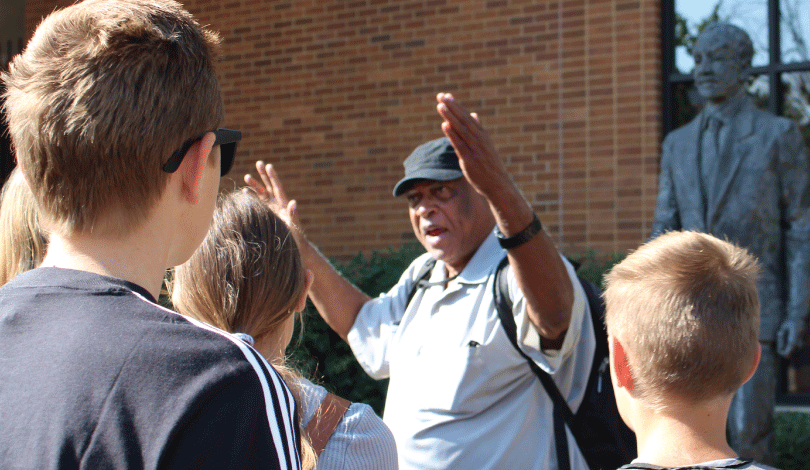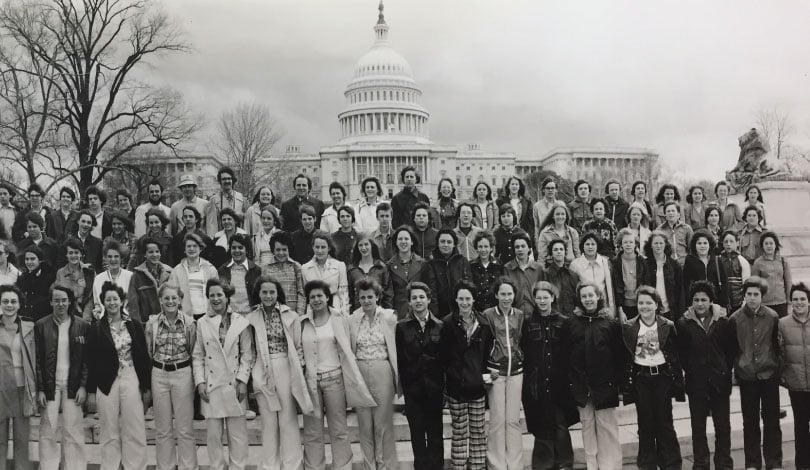This fall, our expert panel led a webinar on "Approaching Civil Rights, Diversity, and Inclusion in your Curriculum and Your Classroom." They shared insights on bringing a diversity of voice to lesson plans and entering into vulnerable and courageous conversations with students. Educators just like you asked engaging and complex questions to help facilitate this valuable work.
We have compiled the panels answers below - keep reading for the panel's thoughtful responses, classroom tips, and personal experiences.
Note: Answers have been edited for length and clarity. Access the recording for the full webinar.
What tips do you have for non-History teachers who would like to bring diversity into their lessons?
Lisa (8th Grade Social Studies Teacher): I can answer that because I also teach English. This is the first year I haven't thought English and Social Studies at the same time. We try to do cross-curriculum work, and it's really a little bit easier than people think it is. It's just aligning your goals: What do you want them to learn? And then working backwards: How are you going to do it?
So, it's not about forcing diversity or inclusion into your math lesson, right? But if algebra is, here's one set of information, here's another, I want the probability, what could you put in the equation of your own experience that would be A? So for some kids, A is simple: I want to get to the basketball court, and I only have 20 minutes for lunch.
Please remember that diversity, inclusion... it's not about using a book that says what she can read. Culturally relevant thinking and pedagogy is allowing those students to bring their experience into the classroom.
So in math, it's the pieces of the formula. If it's science, how does this apply to something in your life? If it's English, you have poetry. You have art. You have music, and you can cross-curriculum that very easily. Our English class does a poem by Paul Laurence Dunbar, "We Wear the Mask." They do work around that, then we take that same poem and say in Social Studies, "Who was wearing a mask today based on the core of the current events happening?"
Katie (8th Grade Social Studies Teacher): The arts are also a huge place to bring in diversity with art and music. We want students to do a reflection piece. We added This Book is Anti-Racist. Our media arts teacher is using the format of the illustrations, and doing big projects with them so they can see themselves. There are lots of ways to bring diversity and civil rights into every year, course, and class.
Jasmine (Education Programs Coordinator, National Center for Civil and Human Rights): I'm a big fan of figuring out how to tie history into theatre. Not just history, but also identity. A lot of times, we don't think about how our identity affects these pieces that we create.
Theatre is a way of telling your story. What is your story? What is your identity? What is the reality you are bringing to the world right now? Then also, how do we discuss it? How do we connect all of these pieces and create a space where people can feel empathetic? That's something we're always trying to do with history. We try to create empathy and compassion. We want people to connect, and theater and the arts do it so well. There are so many subject matters to connect. English is one of the easiest things to connect to history.
You talked about the connections from enslavement to Civil War, to Reconstruction, to Civil Rights. Can you talk about how to move forward and connect to modern or global events?
Katie: One of the resources we use is EJI Resources because Bryan Stevenson has put together the timeline from enslavement to mass incarceration in such a way that everybody can understand it, and it's very accessible.
Lisa: I've taken a lot of courses of using art in my class, art like paintings and museums. That has such a bridge to use when you're going from different areas. You can easily theme that or find a painting of a place or a photograph that's actually the same place from Reconstruction and slavery, and in the '20s and in the '50s. Ask the students, "How do you bridge that? What do you see changed?"
I think a lot of educators get stuck in thinking that you have to give the kids so much information in order for them to come up with the answer, and you don't have to. Kids are smart. Allow them the freedom to think and make your classroom one where they are able to be secure in saying what they're thinking. Help them understand. Ask, "How did you come up with that?" It's not about saying, "You're wrong." It's about saying, "Tell me how you came up with that." Then through asking them what evidence they used, you can point them in the right direction. You can even say, "Wow, I never thought about it. Thank you for sharing your thoughts with me, because I've learned something today."
So making those applications, having a free question out there, and seeing what they say, you'll be surprised how students can make some of those connections. Art is a nice place to start if you're stuck.
Jasmine: I think that's brilliant. When I was working at the Atlanta History Center, we had this image from Reconstruction of Black men in a courtroom, and they are participating. They are part of Congress. Then there is a political cartoon that mirrors that with a bunch of monkeys in a courtroom.
When you juxtapose this with students, you can see very clearly what the reality was and what people were putting in media - two different things, right? What makes today so important? We have social media. We have phones, we can record everything, and it's the same thing that made the Civil Rights movement so important. We didn't intentionally jump from Civil War to Civil Rights. During the Civil Rights movement we had access to media. All of a sudden, there are pictures being posted in newspapers. There are images on your TV's. All of these people who are saying, "Oh, this doesn't exist. People aren't being brutalized in the streets." They're being discredited because we have access to facts.
The same thing is happening now, and it might sound disheartening, but it's a major part of the work we all do. History does repeat itself. And if we don't want history to repeat itself, we continue to educate ourselves on this. And a way in which history is currently repeating itself is how people really dug into Civil Rights and these bigger movements is how people are digging into today. We're digging in because we can see it.
I ignore half the videos sent to me on Instagram or Facebook. I am very aware as a Black woman; I know what's happening. I don't need the evidence, but the evidence is there, just like it was during the Civil Rights movement. That's really important. And to all of the points that we're making: students are really smart. We have to allow them to dig into the issues and look at these juxtapositions.
The Civil Rights movement, how I connect it to today and connect it to enslavement is the reality of police brutality. People who were brutalizing enslaved people became the police. The reason people of color have such an issue with police is because of the history of policing, which was to take enslaved people who are runaways, back to the place that they were. Even if you were freed, if you were seen out in the street and you're black, you were assumed to be a runaway.
The Atlanta race riots of 1906, where a black man was said to have whistled at a white woman, similar to Emmett Till. The headlines shift from there to, he whistled, he touched, he raped, he brutalized, and from there, the white community felt necessary to attack random Black people on the streets. The media was putting this forward.
Between 1906 and the late 1940s, early 1950s, this is real. People are still trying to fight against that. We have our first Freedom Ride. We have people consistently pushing back. We have CORE, who is pushing back. It's not working until media, like media we use today, is put at the forefront, and people are saying, "Oh, there are the Bull Connors of the world." Bull Connor in Birmingham, who is hosing down and sic'ing dogs on children. When there are images of him, people realize: This is happening in my community, and I have to stop it.
The way we map to where we are now is: That's happening. If you look at what your students are looking at on social media, they have access to all of this. They have access to people being brutalized on the streets. They have access to March for Our Lives. Students are saying, "These are people that we knew needed help, who then came into our schools with guns. This is what we're doing to fight against it." They have access beyond our greatest police. The way we connect it is realizing that the big movements in history had access to media, and how we utilize media to our advantage rather than to our detriment.
With everything going on in our political scene, how do you go about teaching character and social development in your classrooms?
Malaika (VP for Diversity & Inclusion - Higher Education, WorldStrides): We are seen as leaders. And one of the best things that we can do is treating our students with respect, but also modeling that vulnerability. We should be finding ways to create that psychological safety in our classrooms, so that students are free and able to ask questions of one another. Also, create the modeling piece where students can ask each other and have disagreements but civil discourse always remains.
Jasmine: I was a big proponent of discussion-based learning. I really enjoy students getting to talk about the realities, and I think this is a big component of the work that I've done. I work with private school students, and they do have a lot of privileges that they don't know they have.
Private school students and I do not have necessarily the same upbringing. Unpack what that means, and what you can do with your privilege, and what you can do with the social realities that you've grown up in.
Give agency to your students. It doesn't matter how old they are. They should be agents in their learning. A big thing that comes up is, how young is too young to talk to students about social injustice, and race, and all of these moving parts we deal with as adults. It's never too young. You change your tactics; you do not change your objective. If your objective is to teach about race or racial injustice, your tactics might be different because of cognitive development, but everything else is the same. Feel free and feel comforted knowing that everyone is working at that same level, because we should be teaching at a younger age. The reason we all feel so disrupted by anti-racism is because we've waited so long to talk about it.
Katie: We work a lot as a school on Social & Emotional Learning (SEL) and developing positive awareness and character. By 8th grade, they have a pretty good understanding. We then take that understanding and try to have the students transfer those ideas to history. For example we spent a lot of time unpacking the first presidential debate - and the students bring to light what they feel, how it made them feel, why, what they think are the reasons it turned out the way it did, etc. And a lot of their ideas are based on the SEL work that they've done for years and continue to do—relationship building, safe spaces, and connections seem to make a lot of sense with this age group.
For more insights on bringing diverse voices into your classroom, watch the webinar or browse our resources.


